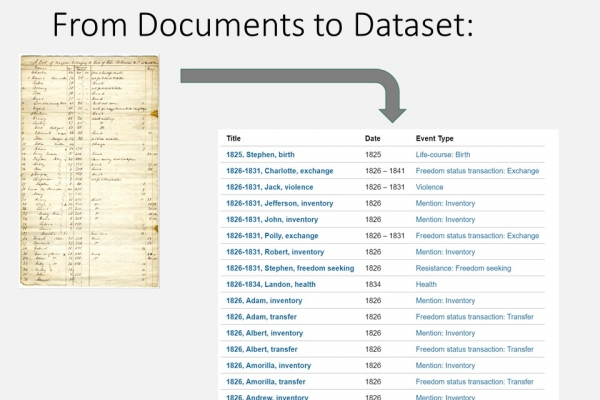Breaking New Ground W&L Library and Institutional History staff joined Mellon-funded initiative On These Grounds with several partner universities to catalog events in enslaved people’s lives.
Washington and Lee University received a grant to become a partner institution for On These Grounds, a project to design and test a data model to describe events in the lives of enslaved people gathered from historical documents. The initiative was funded by the Mellon Foundation using a core team of institutions — Michigan State University, Georgetown University and the University of Virginia — leading the overall process. W&L joined Hampden-Sydney College, Rutgers University, the University of Georgia and the University of North Carolina at Chapel Hill as a testing partner. Lynn Rainville, executive director of institutional history and museums, learned of the initiative and approached University Library staff about a collaboration.
“As more schools implement this model and genealogical and historical data is standardized, the more we will be able to establish connections across documents that have the potential to reconnect families across the South,” Rainville said.
Research into W&L’s past is nothing new. Many W&L staff members, students and alumni have contributed to research over many years. A historical marker installed in 2016 recognizing the enslaved people John “Jockey” Robinson bequeathed to Washington College stands between Chavis and Tucker halls. The difference is how some of the archival materials have been used. Since Rainville joined W&L in 2019, she has worked with Special Collections and Archives to identify more historical resources and digitize important materials.
Assistant Professor and Digital Scholarship Librarian Paula Kiser agreed to manage On These Grounds for W&L and collaborated with the university’s Office of Corporate and Foundation Relations (CFR) to secure the Mellon-funded grant.
“What was really exciting about this project was taking these archival documents and looking at them in a different way,” Kiser explained. “The ontology we were developing and testing was about decentralizing the documents to break out what was happening in these people’s lives, creating data sets that help us better understand a group of people who were integral to our early history and community.”
“This initiative aligns with the university’s goals and also shines a light on the intersections between Institutional History and Museums, the Library and student learning at W&L,” Director of Corporate and Foundation Relations Wendy Lovell said.
Byron Faidley, senior collections assistant and rare materials digitization coordinator, joined the effort along with Mackenzie Brooks, associate professor and digital humanities librarian. Students Madison Williams ’23 and Tanajia Moye-Green ’23 transcribed archival documents with Faidley training them in paleography — the process of deciphering historical manuscripts — and Sujana Basnet ’23 worked with Brooks on the technical side of setting up the Omeka-S data site, which is a web-based cultural heritage exhibit platform used for digital humanities projects.
W&L’s team used Robinson’s bequest in 1826 as a starting point, which included 84 enslaved men, women and children. This gave the research group a large pool of around 35 archival documents connected to the bequest from which to work. The official project kicked off in July 2021 and wrapped up this fall, culminating in the Universities Studying Slavery Fall Forum at UVA. While the grant-funded initiative has ended, W&L plans to expand the site by adding more events, identifying additional documents and increasing the scope in terms of individuals and timeframe.
“Not only does this work play a significant role in helping us understand our own history better at W&L, but it demonstrates that we are part of this larger community of institutions asking the same questions,” Kiser said. “That partnership has been invaluable.”
Williams, a senior geology and environmental studies double-major, transcribed slave inventories, receipts and other memos related to the Robinson estate.
“The most challenging part of the project was piecing together names and familial relationships of everyone listed, however it was very interesting to see the network of enslaved families and learn more about them,” she said. “This work to frame enslaved people in terms of the work they completed and events they took part in, rather than just names listed on a historic document, is crucial to representing our history.”
With the initial phase done, the project team looks forward to collaborating with faculty who could use the site in a variety of ways in the classroom, from further transcription and document identification to data creation and visualizations. “As an example of how this data could be used, we are hoping that we can track an individual’s movements on a period map in the near future,” Faidley said.
“We are beginning to see trends across documents; through the data, it is becoming clearer what ages people were hired out as well as how labor was valued during that time,” Kiser said. “Being able to see all of the events that happened to one person in a single place, as well as the other people they were connected with, and not having to rifle through pages of documents, is groundbreaking,” Kiser said.
Learn more about the project at On These Grounds: Slavery at W&L.
University faculty members who are interested in pursuing external funding opportunities are encouraged to contact cfr@wlu.edu for more information.



You must be logged in to post a comment.